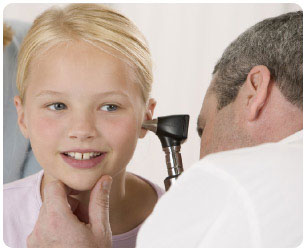Hearing Loss

There are two general types of hearing loss: Conductive hearing loss and Sensorineural hearing loss. In Conductive hearing loss, the transmission of sound from the environment to the inner ear is impaired, usually from an abnormality of the external auditory canal, eardrum or middle ear. This form of hearing loss can be temporary or permanent. Untreated chronic ear infections can lead to conductive hearing loss. If fluid is filling the middle ear, the hearing loss can be treated by inserting a tympanostomy tube to drain the fluid. Sensorineural hearing loss is due to abnormalities of the inner ear or the auditory division of the 8th cranial nerve. This condition can present at all ages, and is usually permanent.
Comprehensive evaluation of hearing loss in children requires a detailed examination of the ear and audiologic evaluation. In some patients, workup may also include imaging studies to evaluate the middle ear and inner ear/auditory nerve (CT of the temporal bone, MRI of the internal auditory canals), eye exam and EKG (for associated ocular and cardiac conditions in some cases of congenital hearing loss) and blood work for genetic mutations testing.
A hearing test should be performed for children who have frequent ear infections, hearing loss that lasts more than six weeks, or fluid in the middle ear for more than three months. The providers at New England ENT offer the full range of audiometric evaluation including threshold testing, tympanometry and OAEs (Otoacoustic emissions).

